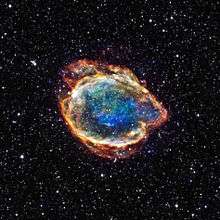Luminous blue variable
Luminous blue variables (LBVs) are massive evolved stars that show unpredictable and sometimes dramatic variations in both their spectra and brightness. They are also known as S Doradus variables after S Doradus, one of the brightest stars of the Large Magellanic Cloud. They are extraordinarily rare with just 20 objects listed in the General Catalogue of Variable Stars as SDor,[1] and a number of these are no longer considered to be LBVs.
.png)
Discovery and history
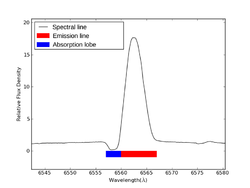
The LBV stars P Cygni and η Carinae have been known as unusual variables since the 17th century, but their true nature was not fully understood until much more recently.
In 1922 John Charles Duncan published the first three variable stars ever detected in an external galaxy, variables 1, 2, and 3, in the Triangulum Galaxy (M33). These were followed up by Edwin Hubble with three more in 1926: A, B, and C in M33. Then in 1929 Hubble added a list of variables detected in M31. Of these, Var A, Var B, Var C, and Var 2 in M33 and Var 19 in M31 were followed up with a detailed study by Hubble and Allan Sandage in 1953. Var 1 in M33 was excluded as being too faint and Var 3 had already been classified as a Cepheid variable. At the time they were simply described as irregular variables, although remarkable for being the brightest stars in those galaxies.[2] The original Hubble Sandage paper contains a footnote that S Doradus might be the same type of star, but expressed strong reservations, so the link would have to wait several decades to be confirmed.
Later papers referred to these five stars as Hubble–Sandage variables. In the 1970s, Var 83 in M33 and AE Andromedae, AF Andromedae (=Var 19), Var 15, and Var A-1 in M31 were added to the list and described by several authors as "luminous blue variables", although it was not considered a formal name at the time. The spectra were found to contain lines with P Cygni profiles and were compared to η Carinae.[3] In 1978, Roberta M. Humphreys published a study of eight variables in M31 and M33 (excluding Var A) and referred to them as luminous blue variables, as well as making the link to the S Doradus class of variable stars.[4] In 1984 in a presentation at the IAU symposium, Peter Conti formally grouped the S Doradus variables, Hubble–Sandage variables, η Carinae, P Cygni, and other similar stars together under the term "luminous blue variables" and shortened it to LBV. He also clearly separated them from those other luminous blue stars, the Wolf–Rayet stars.[5]
Variable star types are usually named after the first member discovered to be variable, for example δ Sct variables named after the star δ Sct. The first luminous blue variable to be identified as a variable star was P Cygni, and these stars have been referred to as P Cygni type variables. The General Catalogue of Variable Stars decided there was a possibility of confusion with P Cygni profiles, which also occur in other types of stars, and chose the acronym SDOR for "variables of the S Doradus type".[6] The term "S Doradus variable" was used to describe P Cygni, S Doradus, η Carinae, and the Hubble-Sandage variables as a group in 1974.[7]
Physical properties

LBVs are massive unstable supergiant (or hypergiant) stars that show a variety of spectroscopic and photometric variation, most obviously periodic outbursts and occasional much larger eruptions.
In their "quiescent" state they are typically B-type stars, occasionally slightly hotter, with unusual emission lines. They are found in a region of the Hertzsprung–Russell diagram known as the S Doradus instability strip, where the least luminous have a temperature around 10,000 K and a luminosity about 250,000 times the Sun, whereas the most luminous have a temperature around 25,000 K and a luminosity over a million times the Sun, making them some of the most luminous of all stars.
During a normal outburst the temperature decreases to around 8,500 K for all stars, slightly hotter than the yellow hypergiants. The bolometric luminosity usually remains constant, which means that visual brightness increases somewhat by a magnitude or two. S Doradus typifies this behaviour. A few examples have been found where luminosity appears to change during an outburst, but the properties of these unusual stars are difficult to determine accurately. For example, AG Carinae may decrease in luminosity by around 30% during outbursts; and AFGL 2298 has been observed to dramatically increase its luminosity during an outburst although it isn't clear if that should be classified as a modest giant eruption.[8] S Doradus typifies this behaviour, which has been referred to as strong-active cycle, and it is regarded as a key criterion for identifying luminous blue variables. Two distinct periodicities are seen, either variations taking longer than 20 years, or less than 10 years. In some cases, the variations are much smaller, less than half a magnitude, with only small temperature reductions. These are referred to as weak-active cycles and always occur on timescales of less than 10 years.[9]
Some LBVs have been observed to undergo giant eruptions with dramatically increased mass loss and luminosity, so violent that several were initially catalogued as supernovae. The outbursts mean there are usually nebulae around such stars; η Carinae is the best-studied and most luminous known example, but may not be typical.[10] It is generally assumed that all luminous blue variables undergo one or more of these large eruptions, but they have only been observed in two or three well-studied stars and possibly a handful of supernova imposters. The two clear examples in our galaxy, P Cygni and η Carinae, and the possible example in the Small Magellanic Cloud, HD 5980A, have not shown strong-cycle variations. It is still possible that the two types of variability occur in different groups of stars.[11] 3-D simulations have shown that these outbursts may be caused by variations in helium opacity.[12]
Many luminous blue variables also show small amplitude variability with periods less than a year, which appear typical of Alpha Cygni variables,[8] and stochastic (i.e. totally random) variations.[9]
Luminous blue variables are by definition more luminous than most stars and also more massive, but within a very wide range. The most luminous are more than a million L☉ and have masses approaching, possibly exceeding, 100 M☉. The least luminous have luminosities around a quarter of a million L☉ and masses as low as 10 M☉, although they would have been considerably more massive as main-sequence stars. They all have high mass loss rates and show some enhancement of helium and nitrogen.[8]
Evolution
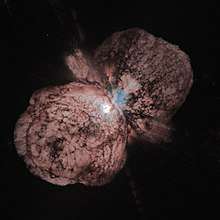
Because of these stars' large mass and high luminosity, their lifetime is very short—only a few million years in total and much less than a million years in the LBV phase.[13] They are rapidly evolving on observable timescales; examples have been detected where stars with Wolf–Rayet spectra (WNL/Ofpe) have developed to show LBV outbursts and a handful of supernovae have been traced to likely LBV progenitors. Recent theoretical research confirms the latter scenario, where luminous blue variable stars are the final evolutionary stage of some massive stars before they explode as supernovae, for at least stars with initial masses between 20 and 25 solar masses.[14] For more-massive stars, computer simulations of their evolution suggest the luminous blue variable phase takes place during the latest phases of core hydrogen burning (LBV with high surface temperature), the hydrogen shell burning phase (LBV with lower surface temperature), and the earliest part of the core helium burning phase (LBV with high surface temperature again) before transitioning to the Wolf–Rayet phase,[15] thus being analogous to the red giant and red supergiant phases of less massive stars.
There appear to be two groups of LBVs, one with luminosities above 630,000 times the Sun and the other with luminosities below 400,000 times the Sun, although this is disputed in more-recent research.[16] Models have been constructed showing that the lower-luminosity group are post-red-supergiants with initial masses of 30–60 times the Sun, whereas the higher-luminosity group are population-II stars with initial masses 60–90 times the Sun that never develop to red supergiants, although they may become yellow hypergiants.[17] Some models suggest that LBVs are a stage in the evolution of very massive stars required for them to shed excess mass,[18] whereas others require that most of the mass is lost at an earlier cool-supergiant stage.[17] Normal outbursts and the stellar winds in the quiescent state are not sufficient for the required mass loss, but LBVs occasionally produce abnormally large outbursts that can be mistaken for a faint supernova and these may shed the necessary mass. Recent models all agree that the LBV stage occurs after the main-sequence stage and before the hydrogen-depleted Wolf–Rayet stage, and that essentially all LBV stars will eventually explode as supernovae. LBVs apparently can explode directly as a supernova, but probably only a small fraction do. If the star does not lose enough mass before the end of the LBV stage, it may undergo a particularly powerful supernova created by pair-instability. The latest models of stellar evolution suggest that some single stars with initial masses around 20 times that of the Sun will explode as LBVs as type II-P, type IIb, or type Ib supernovae,[14] whereas binary stars undergo much-more-complex evolution through envelope stripping leading to less predictable outcomes.[19]
Supernova-like outbursts
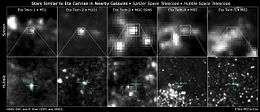
Luminous blue variable stars can undergo "giant outbursts" with dramatically increased mass loss and luminosity. η Carinae is the prototypical example,[20] with P Cygni showing one or more similar outbursts 300–400 years ago,[21] but dozens have now been catalogued in external galaxies. Many of these were initially classified as supernovae but re-examined because of unusual features.[22] The nature of the outbursts and of the progenitor stars seems to be highly variable,[23] with the outbursts most likely having several different causes. The historical η Carinae and P Cygni outbursts, and several seen more recently in external galaxies, have lasted years or decades whereas some of the supernova imposter events have declined to normal brightness within months. Well-studied examples are:
- SN 1954J
- SN 1961V
- SN 1997bs
Early models of stellar evolution had predicted that although the high-mass stars that produce LBVs would often or always end their lives as supernovae, the supernova explosion would not occur at the LBV stage. Prompted by the progenitor of SN 1987A being a blue supergiant, and most likely an LBV, several subsequent supernovae have been associated with LBV progenitors. The progenitor of SN 2005gl has been shown to be an LBV apparently in outburst only a few years earlier.[24] Progenitors of several other type IIn supernovae have been detected and were likely to have been LBVs:[25]
- SN 2009ip
- SN 2010jl
Modelling suggests that at near-solar metallicity, stars with an initial mass around 20–25 M☉ will explode as a supernova while in the LBV stage of their lives. They will be post-red-supergiants with luminosities a few hundred thousand times that of the Sun. The supernova is expected to be of type II, most likely type IIb, although possibly type IIn due to episodes of enhanced mass loss that occur as an LBV and in the yellow-hypergiant stage.[26]
List of LBVs
The identification of LBVs requires confirmation of the characteristic spectral and photometric variations, but these stars can be "quiescent" for decades or centuries at which time they are indistinguishable from many other hot luminous stars. A candidate luminous blue variable (cLBV) can be identified relatively quickly on the basis of its spectrum or luminosity, and dozens have been catalogued in the Milky Way during recent surveys.[27]
Recent studies of dense clusters and mass spectrographic analysis of luminous stars have identified dozens of probable LBVs in the Milky Way out of a likely total population of just a few hundred, although few have been observed in enough detail to confirm the characteristic types of variability. In addition the majority of the LBVs in the Magellanic Clouds have been identified, several dozen in M31 and M33, plus a handful in other local group galaxies.[28]
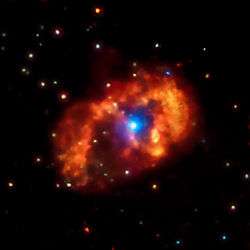
Our galaxy:
- η Carinae
- P Cygni
- V4650 Sagittarii (FMM 362 or qF362, in the Quintuplet cluster)
- V4998 Sagittarii (LBV3, G0.120 0.048, very close to the Quintuplet cluster)
- AG Carinae
- HR Carinae
- V432 Carinae (Wray 15-751)
- V4029 Sagittarii (HD 168607)
- V905 Scorpii (HD 160529)
- V1672 Aquilae (AFGL 2298)
- W1-243 (in Westerlund 1)
- V481 Scuti (LBV G24.73+0.69)
- GCIRS 34W
- MWC 930[29] (= V446 Scuti)
- Wray 16-137[30]
- WS1 (discovered as WISE Shell 1[31])[32]
- MN44[33]
- MN48[34]
LMC:
- S Doradus
- HD 269858 (= R127)
- HD 269006 (= R71)
- HD 269929 (= R143)
- HD 269662 (= R110)
- HD 269700 (= R116)[35]
- HD 269582 (= MWC 112)
- HD 269216[36]
SMC:
- HD 5980 (= R14)
- HD 6884 (= R40)
M31:
- AF Andromedae[37]
- AE Andromedae[37]
- Var 15[37]
- Var A-1[37]
- J004526.62+415006.3[38]
- J004051.59+403303.0[38]
- LAMOST J0037+4016[39]
M33:
- Var 2[37] (an extremely hot star showing no variability since 1935 and hardly studied)
- Var 83[37]
- Var B[37]
- Var C[37]
- GR 290[40] (Romano's star, an unusually hot LBV[41])
- Unnamed star that has undergone an outburst and unusual supernova-like event and now disappeared[43]
A number of cLBVs in the Milky Way are well known because of their extreme luminosity or unusual characteristics, including:
- Wray 17-96 (unusual hypergiant in the gap between the two semi-stable LBV regions)
- Pistol Star (once thought to be the most luminous star in the galaxy)
- LBV 1806-20 (one of the most luminous stars known)
- Sanduleak -69° 202 (the star that exploded as SN 1987A)
- Cygnus OB2-12 (blue hypergiant and one of the most luminous stars known)
- HD 80077 (blue hypergiant)
- V1429 Aquilae (with a supergiant companion, very similar to a less luminous η Car)
- V4030 Sagittarii (hypergiant surrounded by a nebula identical to the one around Sanduleak -69° 202)
- WR 102ka (the Peony star, one of the most luminous stars known, and would be one of the hottest LBVs)
- Sher 25 (blue supergiant in NGC 3603 with a bipolar outflow and surrounded by a circumstellar ring)
- BD+40°4210 (blue supergiant in the stellar association Cygnus OB2)
Other well-known stars not currently classified as LBVs but may be transitioning into LBVs, have been LBVs relatively recently, or are LBVs in a stable phase include:
- Zeta-1 Scorpii (naked-eye hypergiant)
- IRC+10420 (yellow hypergiant that has increased its temperature into the LBV range)
- V509 Cassiopeiae (= HR 8752, an unusual yellow hypergiant evolving bluewards)
- Rho Cassiopeiae (unstable yellow hypergiant suffering periodic outbursts)
See also
References
- "GCVS Variability Types". General Catalogue of Variable Stars @ Sternberg Astronomical Institute, Moscow, Russia. 12 Feb 2009. Retrieved 2010-11-24.
- Hubble, Edwin; Sandage, Allan (1953). "The Brightest Variable Stars in Extragalactic Nebulae. I. M31 and M33". Astrophysical Journal. 118: 353. Bibcode:1953ApJ...118..353H. doi:10.1086/145764.
- Bianchini, A.; Rosino, L. (1975). "The spectrum of the bright variable A-1 in M31". Astronomy and Astrophysics. 42: 289. Bibcode:1975A&A....42..289B.
- Humphreys, R. M. (1978). "Luminous variable stars in M31 and M33". The Astrophysical Journal. 219: 445. Bibcode:1978ApJ...219..445H. doi:10.1086/155797.
- Conti, P. S. (1984). Basic Observational Constraints on the Evolution of Massive Stars. Observational Tests of the Stellar Evolution Theory. International Astronomical Union Symposium No. 105. 105. pp. 233–254. Bibcode:1984IAUS..105..233C. doi:10.1007/978-94-010-9570-9_47. ISBN 978-90-277-1775-7.
- Sharov, A. S. (1975). "S Dor-type variables in other galaxies". In: Variable Stars and Stellar Evolution; Proceedings of the Symposium. 67: 275–284. Bibcode:1975IAUS...67..275S. doi:10.1007/978-94-010-9934-9_38. ISBN 978-90-277-0579-2.
- Thackeray, A. D. (1974). "Variations of S Dor and HDE 269006". Monthly Notices of the Royal Astronomical Society. 168: 221–233. Bibcode:1974MNRAS.168..221T. doi:10.1093/mnras/168.1.221.
- Vink, Jorick S. (2012). "Eta Carinae and the Luminous Blue Variables". Eta Carinae and the Supernova Impostors. Eta Carinae and the Supernova Impostors. Astrophysics and Space Science Library. 384. pp. 221–247. arXiv:0905.3338. Bibcode:2012ASSL..384..221V. CiteSeerX 10.1.1.250.4184. doi:10.1007/978-1-4614-2275-4_10. ISBN 978-1-4614-2274-7.
- Sterken, C. (2003). "Cycles and cyclicities in Luminous Blue Variables: The S Dor phenomenon". Interplay of Periodic. 292: 437. Bibcode:2003ASPC..292..437S.
- Guzik, Joyce A.; Lovekin, Catherine C. (2014). "Pulsations and Hydrodynamics of Luminous Blue Variable Stars". arXiv:1402.0257v1 [SR astro-ph. SR].
- van Genderen, A. M. (2001). "S Doradus variables in the Galaxy and the Magellanic Clouds". Astronomy and Astrophysics. 366 (2): 508–531. Bibcode:2001A&A...366..508V. doi:10.1051/0004-6361:20000022. ISSN 0004-6361.
- Jiang, Yan-Fei; Cantiello, Matteo; Bildsten, Lars; Quataert, Eliot; Blaes, Omer; Stone, James (September 2018). "Outbursts of luminous blue variable stars from variations in the helium opacity". Nature. 561 (7724): 498–501. arXiv:1809.10187. Bibcode:2018Natur.561..498J. doi:10.1038/s41586-018-0525-0. ISSN 0028-0836. PMID 30258134.
- Groh, Jose; Meynet, Georges; Ekstrom, Sylvia; Georgy, Cyril (2014). "The evolution of massive stars and their spectra I. A non-rotating 60 Msun star from the zero-age main sequence to the pre-supernova stage". Astronomy & Astrophysics. 564: A30. arXiv:1401.7322. Bibcode:2014A&A...564A..30G. doi:10.1051/0004-6361/201322573.
- Groh, J. H.; Meynet, G.; Ekström, S. (2013). "Massive star evolution: Luminous blue variables as unexpected supernova progenitors". Astronomy & Astrophysics. 550: L7. arXiv:1301.1519. Bibcode:2013A&A...550L...7G. doi:10.1051/0004-6361/201220741.
- Groh, Jose; Meynet, Georges; Ekstrom, Sylvia; Georgy, Cyril (2014). "The evolution of massive stars and their spectra I. A non-rotating 60 Msun star from the zero-age main sequence to the pre-supernova stage". Astronomy & Astrophysics. 564: A30. arXiv:1401.7322. Bibcode:2014A&A...564A..30G. doi:10.1051/0004-6361/201322573.
- Groh, Jose H.; Meynet, Georges; Georgy, Cyril; Ekström, Sylvia (2013). "Fundamental properties of core-collapse supernova and GRB progenitors: Predicting the look of massive stars before death". Astronomy & Astrophysics. 558: A131. arXiv:1308.4681. Bibcode:2013A&A...558A.131G. doi:10.1051/0004-6361/201321906.
- Stothers, Richard B.; Chin, Chao-Wen (1996). "Evolution of Massive Stars into Luminous Blue Variables and Wolf-Rayet Stars for a Range of Metallicities: Theory versus Observation". The Astrophysical Journal. 468: 842. Bibcode:1996ApJ...468..842S. doi:10.1086/177740.
- Smith, Nathan; Owocki, Stanley P. (2006). "On the Role of Continuum-driven Eruptions in the Evolution of Very Massive Stars and Population III Stars". The Astrophysical Journal. 645 (1): L45. arXiv:astro-ph/0606174. Bibcode:2006ApJ...645L..45S. doi:10.1086/506523.
- Sana, H.; De Mink, S. E.; De Koter, A.; Langer, N.; Evans, C. J.; Gieles, M.; Gosset, E.; Izzard, R. G.; Le Bouquin, J.- B.; Schneider, F. R. N. (2012). "Binary Interaction Dominates the Evolution of Massive Stars". Science. 337 (6093): 444–6. arXiv:1207.6397. Bibcode:2012Sci...337..444S. doi:10.1126/science.1223344. PMID 22837522.
- Smith, N.; Frew, D. J. (2011). "A revised historical light curve of Eta Carinae and the timing of close periastron encounters". Monthly Notices of the Royal Astronomical Society. 415 (3): 2009–2019. arXiv:1010.3719. Bibcode:2011MNRAS.415.2009S. doi:10.1111/j.1365-2966.2011.18993.x.
- Humphreys, R. M.; Davidson, K.; Smith, N. (1999). "Eta Carinae's Second Eruption and the Light Curves of the eta Carinae Variables". Publications of the Astronomical Society of the Pacific. 111 (763): 1124–1131. Bibcode:1999PASP..111.1124H. doi:10.1086/316420.
- Smith, Nathan; Li, Weidong; Silverman, Jeffrey M.; Ganeshalingam, Mohan; Filippenko, Alexei V. (2011). "Luminous blue variable eruptions and related transients: Diversity of progenitors and outburst properties". Monthly Notices of the Royal Astronomical Society. 415 (1): 773. arXiv:1010.3718. Bibcode:2011MNRAS.415..773S. doi:10.1111/j.1365-2966.2011.18763.x.
- Kochanek, C. S.; Szczygieł, D. M.; Stanek, K. Z. (2012). "Unmasking the Supernova Impostors". The Astrophysical Journal. 758 (2): 142. arXiv:1202.0281. Bibcode:2012ApJ...758..142K. doi:10.1088/0004-637X/758/2/142.
- Gal-Yam, A.; Leonard, D. C. (2009). "A massive hypergiant star as the progenitor of the supernova SN 2005gl". Nature. 458 (7240): 865–7. Bibcode:2009Natur.458..865G. doi:10.1038/nature07934. PMID 19305392.
- Tartaglia, L.; Pastorello, A.; Sullivan, M.; Baltay, C.; Rabinowitz, D.; Nugent, P.; Drake, A. J.; Djorgovski, S. G.; Gal-Yam, A.; Fabrika, S.; Barsukova, E. A.; Goranskij, V. P.; Valeev, A. F.; Fatkhullin, T.; Schulze, S.; Mehner, A.; Bauer, F. E.; Taubenberger, S.; Nordin, J.; Valenti, S.; Howell, D. A.; Benetti, S.; Cappellaro, E.; Fasano, G.; Elias-Rosa, N.; Barbieri, M.; Bettoni, D.; Harutyunyan, A.; Kangas, T.; et al. (2016). "Interacting supernovae and supernova impostors. LSQ13zm: An outburst heralds the death of a massive star". Monthly Notices of the Royal Astronomical Society. 459 (1): 1039. arXiv:1604.00013. Bibcode:2016MNRAS.459.1039T. doi:10.1093/mnras/stw675.
- Groh, J. H.; Meynet, G.; Ekström, S. (2013). "Massive star evolution: Luminous blue variables as unexpected supernova progenitors". Astronomy & Astrophysics. 550: L7. arXiv:1301.1519. Bibcode:2013A&A...550L...7G. doi:10.1051/0004-6361/201220741.
- Nazé, Y.; Rauw, G.; Hutsemékers, D. (2012). "The first X-ray survey of Galactic luminous blue variables". Astronomy & Astrophysics. 538: A47. arXiv:1111.6375. Bibcode:2012A&A...538A..47N. doi:10.1051/0004-6361/201118040.
- Richardson, Noel D.; Mehner, Andrea (2018). "The 2018 Census of Luminous Blue Variables in the Local Group". Research Notes of the American Astronomical Society. 2 (3): 121. arXiv:1807.04262. Bibcode:2018RNAAS...2c.121R. doi:10.3847/2515-5172/aad1f3.
- Miroshnichenko, A. S.; Manset, N.; Zharikov, S. V.; Zsargó, J.; Juárez Jiménez, J. A.; Groh, J. H.; Levato, H.; Grosso, M.; Rudy, R. J.; Laag, E. A.; Crawford, K. B.; Puetter, R. C.; Reichart, D. E.; Ivarsen, K. M.; Haislip, J. B.; Nysewander, M. C.; Lacluyze, A. P. (2014). "Confirmation of the Luminous Blue Variable Status of MWC 930". Advances in Astronomy. 2014: 1–9. arXiv:1404.1121. Bibcode:2014AdAst2014E...7M. doi:10.1155/2014/130378.
- Gvaramadze, V. V.; Kniazev, A. Y.; Berdnikov, L. N.; Langer, N.; Grebel, E. K.; Bestenlehner, J. M. (2014). "Discovery of a new Galactic bona fide luminous blue variable with Spitzer★". Monthly Notices of the Royal Astronomical Society: Letters. 445: L84–L88. arXiv:1408.6232. Bibcode:2014MNRAS.445L..84G. doi:10.1093/mnrasl/slu141.
- Gvaramadze, V. V.; Kniazev, A. Y.; Miroshnichenko, A. S.; Berdnikov, L. N.; Langer, N.; Stringfellow, G. S.; Todt, H.; Hamann, W.-R.; Grebel, E. K.; Buckley, D.; Crause, L.; Crawford, S.; Gulbis, A.; Hettlage, C.; Hooper, E.; Husser, T.-O.; Kotze, P.; Loaring, N.; Nordsieck, K. H.; O’Donoghue, D.; Pickering, T.; Potter, S.; Romero Colmenero, E.; Vaisanen, P.; Williams, T.; Wolf, M.; Reichart, D. E.; Ivarsen, K. M.; Haislip, J. B.; Nysewander, M. C.; LaCluyze, A. P. (2012). "Discovery of two new Galactic candidate luminous blue variables with Wide-field Infrared Survey Explorer★" (PDF). Monthly Notices of the Royal Astronomical Society. 421 (4): 3325–3337. arXiv:1201.2854. Bibcode:2012MNRAS.421.3325G. doi:10.1111/j.1365-2966.2012.20556.x. ISSN 0035-8711.
- Kniazev, A. Y.; Gvaramadze, V. V.; Berdnikov, L. N. (2015). "WS1: One more new Galactic bona fide luminous blue variable★". Monthly Notices of the Royal Astronomical Society: Letters. 449: L60–L64. arXiv:1502.07361. Bibcode:2015MNRAS.449L..60K. doi:10.1093/mnrasl/slv023.
- Gvaramadze, V. V.; Kniazev, A. Y.; Berdnikov, L. N. (2015). "Discovery of a new bona fide luminous blue variable in Norma". Monthly Notices of the Royal Astronomical Society. 454 (4): 3710. arXiv:1509.08931. Bibcode:2015MNRAS.454.3710G. doi:10.1093/mnras/stv2278.
- Kniazev, A. Y.; Gvaramadze, V. V.; Berdnikov, L. N. (2016). "MN48: A new Galactic bona fide luminous blue variable revealed by Spitzer and SALT★". Monthly Notices of the Royal Astronomical Society. 459 (3): stw889. arXiv:1604.03942. Bibcode:2016MNRAS.459.3068K. doi:10.1093/mnras/stw889.
- "HD 269700". SIMBAD. Centre de données astronomiques de Strasbourg. Retrieved 16 July 2017.
- Walborn, Nolan R.; Gamen, Roberto C.; Morrell, Nidia I.; Barbá, Rodolfo H.; Fernández Lajús, Eduardo; Angeloni, Rodolfo (2017). "Active Luminous Blue Variables in the Large Magellanic Cloud". The Astronomical Journal. 154 (1): 15. Bibcode:2017AJ....154...15W. doi:10.3847/1538-3881/aa6195.
- Humphreys, Roberta M.; Weis, Kerstin; Davidson, Kris; Bomans, D. J.; Burggraf, Birgitta (2014). "LUMINOUS AND VARIABLE STARS IN M31 AND M33. II. LUMINOUS BLUE VARIABLES, CANDIDATE LBVs, Fe II EMISSION LINE STARS, AND OTHER SUPERGIANTS". The Astrophysical Journal. 790 (1): 48. arXiv:1407.2259. Bibcode:2014ApJ...790...48H. doi:10.1088/0004-637X/790/1/48.
- Sholukhova, O.; Bizyaev, D.; Fabrika, S.; Sarkisyan, A.; Malanushenko, V.; Valeev, A. (2015). "New luminous blue variables in the Andromeda galaxy". Monthly Notices of the Royal Astronomical Society. 447 (3): 2459. arXiv:1412.5319. Bibcode:2015MNRAS.447.2459S. doi:10.1093/mnras/stu2597.
- Huang, Y.; Zhang, H.-W.; Wang, C.; Chen, B.-Q.; Zhang, Y.-W.; Guo, J.-C.; Yuan, H.-B.; Xiang, M.-S.; Tian, Z.-J.; Li, G.-X.; Liu, X.-W. (2019). "A New Luminous Blue Variable in the Outskirts of the Andromeda Galaxy". The Astrophysical Journal. 884 (1): L7. arXiv:1909.04832. Bibcode:2019ApJ...884L...7H. doi:10.3847/2041-8213/ab430b.
- Maryeva, Olga (2014). "The half-century history of studies of Romano's star". Baltic Astronomy. 23 (3–4): 248. arXiv:1411.2662. Bibcode:2014BaltA..23..248M. doi:10.1515/astro-2017-0187.
- Polcaro, V. F.; Maryeva, O.; Nesci, R.; Calabresi, M.; Chieffi, A.; Galleti, S.; Gualandi, R.; Haver, R.; Mills, O. F.; Osborn, W. H.; Pasquali, A.; Rossi, C.; Vasilyeva, T.; Viotti, R. F. (2016). "GR 290 (Romano's Star): 2. Light history and evolutionary state". The Astronomical Journal. 151 (6): 149. arXiv:1603.07284. Bibcode:2016AJ....151..149P. doi:10.3847/0004-6256/151/6/149.
- Humphreys, Roberta M.; Stangl, Sarah; Gordon, Michael S.; Davidson, Kris; Grammer, Skyler H. (2018). "Luminous and Variable Stars in NGC 2403 and M81". The Astronomical Journal. 157: 22. arXiv:1811.06559. doi:10.3847/1538-3881/aaf1ac.
- Burke, Colin J.; et al. (May 2020). "The Curious Case of PHL 293B: A Long-lived Transient in a Metal-poor Blue Compact Dwarf Galaxy". The Astrophysical Journal Letters. 894 (1). arXiv:2002.12369. Bibcode:2020ApJ...894L...5B. doi:10.3847/2041-8213/ab88de.

